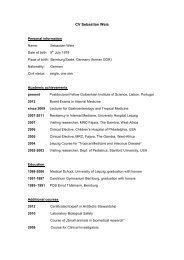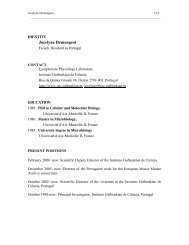organisation - the Instituto Gulbenkian de Ciência
organisation - the Instituto Gulbenkian de Ciência
organisation - the Instituto Gulbenkian de Ciência
- No tags were found...
Create successful ePaper yourself
Turn your PDF publications into a flip-book with our unique Google optimized e-Paper software.
LEARNING<br />
LABORATORY<br />
THIS GROUP IS A MEMBER OF THE CHAMPALIMAUD NEUROSCIENCE PROGRAMME AT THE IGC<br />
Joseph Paton Research Fellow<br />
PhD in Neurobiology and Behaviour, Columbia University, 2008<br />
Research Fellow at <strong>the</strong> IGC since 2008<br />
link to external website<br />
Learning to adaptively respond to cues in <strong>the</strong> environment that predict behaviourally<br />
relevant events is critical for survival. However, in <strong>the</strong> natural world,<br />
where animals are exposed to myriad sensory stimuli, learning <strong>the</strong> predictive<br />
value of cues is non-trivial. How do animals figure out which cues are predictive,<br />
and of what? This is called <strong>the</strong> credit assignment problem. Conceiving of<br />
this problem as statistical inference in <strong>the</strong> time domain offers a parsimonious<br />
account of animals’ learning abilities. In o<strong>the</strong>r words, when cues occur relative<br />
to meaningful events is what <strong>de</strong>termines <strong>the</strong>ir information content, <strong>the</strong>ir usefulness,<br />
and thus, whe<strong>the</strong>r <strong>the</strong>y warrant learning about. However, we still do not<br />
un<strong>de</strong>rstand how <strong>the</strong> brain might keep track of times. We aim to reveal neural<br />
mechanisms for time by observing and manipulating neurophysiology in behaving<br />
ro<strong>de</strong>nts performing tasks that lead <strong>the</strong>m to estimate intervals.<br />
GROUP MEMBERS<br />
Gonçalo Lopes (PhD stu<strong>de</strong>nt, shared with Adam Kampff)<br />
Gustavo Mello (PhD stu<strong>de</strong>nt)<br />
Rui Azevedo (PhD stu<strong>de</strong>nt, shared with Zach Mainen))<br />
Sofia Soares (Technician)<br />
COLLABORATORS<br />
Joshua T. Dudman (Janelia Farm Research Campus, USA)<br />
Adam R. Kampff (Champalimaud Neuroscience Programme, Portugal)<br />
FUNDING<br />
Champalimaud Foundation (CF),Portugal<br />
Fundação para a Ciência e a Tecnologia (FCT), Portugal<br />
OPTOGENETIC INVESTIGATION OF INTERVAL TIMING IN MICE<br />
In <strong>the</strong> past year, we have initiated a parallel set of timing studies in mice in<br />
or<strong>de</strong>r to take advantage <strong>the</strong> increased molecular power of <strong>the</strong> mouse relative<br />
to <strong>the</strong> rat. We have trained mice on a classic temporal reproduction task, called<br />
<strong>the</strong> peak interval task, and are currently training mice on <strong>the</strong> SFI task mentioned<br />
above. By combining viruses <strong>de</strong>pen<strong>de</strong>nt on CRE recombinase activity<br />
for expression of transgenes, with mouse lines expressing CRE in specific basal<br />
ganglia cell types, we plan to express light sensitive channels and pumps in targeted<br />
locations within <strong>the</strong> basal ganglia circuit. Stimulating <strong>the</strong>se proteins with<br />
light during experiments will provi<strong>de</strong> us with two potentially powerful pieces of<br />
data. First, we will be able to ask what type of cell we are recording from in vivo<br />
much more easily and in higher volume than was available with ol<strong>de</strong>r techniques.<br />
Second, we can test hypo<strong>the</strong>ses about <strong>the</strong> role of activity in specific populations<br />
of neurons for timing behaviour.<br />
In <strong>the</strong> past year Rui Azevedo has activated dopamine neurons using optogenetics<br />
in brain slices, and in behaving mice. He gained behavioural evi<strong>de</strong>nce<br />
of successful activation by showing that he could condition mice to prefer a<br />
particular spatial location by illuminating transfected neurons specifically when<br />
mice entered a particular region. He is currently training transgenic mice on a<br />
timing task, and will test whe<strong>the</strong>r manipulation of dopamine neuron activity<br />
affects interval timing.<br />
NEUROPHYSIOLOGY OF TIME ENCODING IN THE RODENT STRIATUM<br />
Lesion, pharmacology, and genetic studies all suggest that <strong>the</strong> ability to estimate<br />
<strong>the</strong> passage of time on <strong>the</strong> scale of seconds to minutes is produced in<br />
<strong>the</strong> striatum, a major input area of <strong>the</strong> basal ganglia. Thus, we trained rats to<br />
estimate time intervals and recor<strong>de</strong>d from striatal neurons as <strong>the</strong>y behaved<br />
and asked how <strong>the</strong> passage of time could be enco<strong>de</strong>d in <strong>the</strong> firing patterns we<br />
observed. In addition, <strong>the</strong> basal ganglia is thought to implement reinforcement<br />
learning mechanisms, helping <strong>the</strong> animal learn how to act in response to a given<br />
situation based on past experience. We sought to place <strong>the</strong> neural signals we<br />
recor<strong>de</strong>d into a computational framework that reconciles interval timing and<br />
reinforcement learning. Towards that end, we are <strong>de</strong>veloping a computational<br />
mo<strong>de</strong>l of interval timing that inclu<strong>de</strong>s signals related to those we observe experimentally,<br />
but that also can solve reinforcement learning problems.<br />
We currently have a manuscript in <strong>the</strong> final stages of preparation <strong>de</strong>scribing <strong>the</strong><br />
neural signals we observe during an interval timing task. We are also actively<br />
extending <strong>the</strong>se studies to gain more continuous measures of <strong>the</strong> animals’ behaviour<br />
during our task. This will be important for continuing to rule out behavioural<br />
sources of variance in <strong>the</strong> firing of neurons we record.<br />
Mo<strong>de</strong>lling rats’ behaviour using mechanisms <strong>de</strong>rived from experimental data. Output<br />
of a timing mo<strong>de</strong>l running on a task that we have previously trained rats to<br />
perform. At <strong>the</strong> top are scalable temporal basis functions that resemble <strong>the</strong> activity<br />
profiles of neurons we have recor<strong>de</strong>d in <strong>the</strong> striatum of rats during this task.<br />
These are used as rate functions to produce Poisson spike trains. These spike<br />
trains are <strong>the</strong>n <strong>de</strong>co<strong>de</strong>d to estimate time (blue trace) and subsequently drive behaviour<br />
(red threshold).<br />
IGC ANNUAL REPORT ‘11<br />
RESEARCH FELLOWS<br />
79






